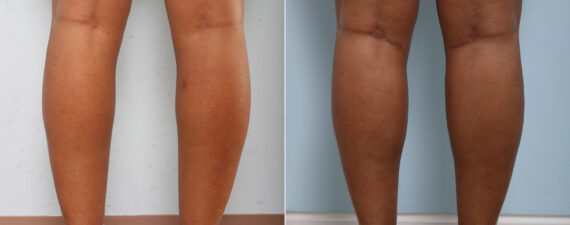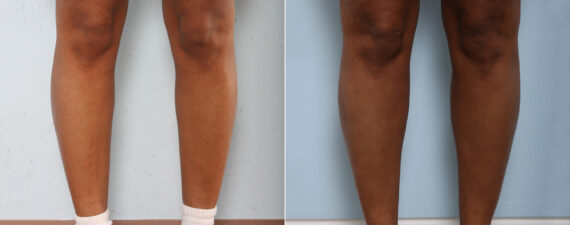Silicone calf implants, a specialized surgical material, are expertly designed to enhance the appearance and size of the lower legs. Ideal for both cosmetic and medical applications, these implants cater to individuals seeking to harmonize their body proportions or those requiring muscle rebuilding due to illness or injury.
Dr. Paul Vitenas, renowned for his proficiency in utilizing this material for calf augmentation, offers comprehensive guidance on the entire process. His expertise covers the procedural details, recovery management, and long-term expectations associated with these implants.

Insights on Silicone Calf Implants
- There are two main types of silicone calf implants, solid and gel-filled, each offering distinct benefits like durability and a natural feel.
- The success of calf implant surgery hinges on tailoring the implant’s size and shape to match each individual’s body and desired aesthetics.
- Implant appearance can be affected by aging, weight changes, and physical activity, making regular check-ups with a surgeon essential.
- Advanced surgical techniques are used to minimize scarring, and medical-grade silicone is both safe and MRI-compatible.
- Patients can usually return to normal activities within a week after surgery but should be mindful of temporary sensation changes and the importance of scar management.
1. Types of Silicone Calf Implants: Solid vs. Gel-Filled
When considering calf implant surgery, understanding the types of silicone implants available is crucial. Dr. Vitenas, a renowned expert in cosmetic surgeries, explains that there are primarily two types of silicone calf implants: solid silicone implants and those filled with silicone gel. Solid silicone implants are firm and pre-shaped, offering a more defined calf contouring. On the other hand, gel-filled implants provide a softer, more natural feel, closely mimicking the natural calf muscle.
Solid Silicone Implants
- Durability: Known for their resilience, solid implants maintain shape over many years.
- Aesthetic Outcomes: Provide a more pronounced calf enlargement, ideal for those seeking significant calf augmentation.
Gel-Filled Silicone Implants
- Realistic Feel: Mimic the softness of natural gastrocnemius muscles.
- Natural Appearance: Suitable for subtle calf enhancement, they blend seamlessly with the leg’s natural contours.
2. The Role of Gastrocnemius Muscles in Calf Augmentation
Calf augmentation surgery aims to enhance the size and shape of the calf muscle. Dr. Vitenas emphasizes the importance of understanding the anatomy involved, particularly the gastrocnemius muscles. These muscles, located in the lower leg, play a vital role in calf implant procedures. Their shape and tone influence the final result of the surgery.
- Muscle Tone: Candidates with good muscle tone typically achieve more aesthetically pleasing results.
- Gastrocnemius Calf Muscle: The target area for implant placement, influencing calf size and overall leg shape.
3. Customizing Your Implants: Size and Shape Options
Customization is key in calf implant surgery. Dr. Vitenas offers private consultations to discuss various implant designs and sizes. These custom implants are tailored to match each patient’s body type and desired aesthetic outcomes. The choice between different implant shapes and sizes allows for a personalized approach to calf augmentation.
- Implant Size: Determines the extent of calf enlargement.
- Implant Shape: Influences the calf’s final shape, whether more rounded or angular.
4. Durability and Longevity of Silicone Implants
Silicone implants are celebrated for their longevity and resilience. Medical-grade silicone, used in both solid and gel-filled implants, is resistant to aging and maintains its shape over time. Dr. Vitenas assures patients that with proper care, their implants can last for many years, sustaining the desired cosmetic enhancement.
- Resistance to Aging: Implants retain their shape, resisting wear and tear.
- Long-Term Performance: Continuously provide the desired calf contouring without significant changes.
5. Sensation and Movement Post-Implant Surgery

One common concern among candidates for calf implants is the impact on sensation and physical activity post-surgery. Dr. Vitenas explains that while some temporary changes in sensation are normal, the vast majority of patients regain full feeling and mobility within a couple of days to a week after surgery.
- Temporary Sensation Loss: Common but typically short-lived.
- Physical Activity: Patients can usually resume normal activities soon, with strenuous activity allowed after full recovery.
6. Aesthetic Outcomes: Comparing Solid and Gel-Filled Implants
Choosing between solid and gel-filled implants depends on the patient’s aesthetic purposes. Dr. Vitenas helps patients set realistic expectations based on the implant type. While solid implants offer more pronounced calf size enhancement, gel-filled implants provide a subtler, more natural calf shape.
- Solid Implants: Ideal for significant calf contouring.
- Gel-Filled Implants: Best for those seeking a natural, shapelier calf enhancement.
7. Surgical Techniques for Implant Insertion
The surgical procedure for calf implantation is a meticulous process, performed by experienced plastic surgeons like Dr. Vitenas. This outpatient procedure typically involves creating incisions in natural creases near the knee or in the popliteal fossa, minimizing scar visibility.
- Incision Placement: Strategic incisions reduce visible scarring.
- Implant Positioning: Careful placement ensures natural integration with existing calf muscles.
8. Scarring and Its Visibility
Scarring is an inevitable aspect of any cosmetic surgery, including calf implant procedures. However, incisions are usually made in areas that are less visible, and scar tissue typically fades over time.
- Incision Technique: Utilizes natural creases to minimize noticeable scarring.
- Scar Management: Post-operative care includes treatments to promote optimal healing of scar tissue.
9. Allergy Considerations with Silicone Materials
Silicone, a widely used material in cosmetic procedures, is generally well-tolerated. However, individuals with allergies to foreign material, specifically silicone, should discuss alternatives with Dr. Vitenas.
- Allergy Testing: Blood tests may be necessary to rule out allergies to silicone.
- Material Safety: Silicone implants are typically made of medical-grade materials to minimize allergic reactions.
10. Revision Surgeries: When and Why
While silicone calf implants are designed for longevity, revision surgeries might be required in cases of implant displacement, capsular contracture, or patient desire for a different implant size or shape.
- Implant Displacement: Corrective surgery addresses any shifts in implant position.
- Capsular Contracture: Occurs when connective tissue around the implant tightens, necessitating surgical intervention.

11. The Impact of Weight Changes and Physical Activity
Significant weight fluctuations or intense physical activity can affect the appearance and integrity of calf implants. Understanding the relationship between these factors and calf augmentations is essential for maintaining long-term results.
- Weight Changes: Substantial weight gain or loss may alter the appearance of the implants relative to surrounding tissue.
- Physical Activity: Regular activity is encouraged post-recovery, but extreme strenuous activity should be approached with caution to avoid the risk of injury.
12. MRI Compatibility of Silicone Calf Implants
Patients with silicone calf implants may have concerns regarding MRI procedures. Typically, medical-grade silicone used in implants does not interfere with MRI scans, but it is vital to inform the radiologist of their presence.
- MRI Safety: Inform medical professionals about implants prior to undergoing MRI scans.
- Image Clarity: Implants may cause minor distortions in MRI images of the leg area but generally do not impede diagnostic processes.
13. How Aging Affects Silicone Implants
Aging can influence the look and feel of calf implants. While the implants themselves do not age, changes in skin elasticity and muscle tone over time may impact their appearance.
- Skin Changes: As skin loses elasticity, the overlaying appearance of the implants may alter slightly.
- Muscle Tone Variation: Age-related changes in leg muscles can affect the overall appearance of calf augmentation surgery.
14. Long-Term Health Monitoring and Check-Ups
Regular follow-up appointments with Dr. Vitenas are crucial for monitoring the condition of calf implants. These check-ups help ensure the implants remain in good condition and identify any potential complications early.
- Routine Examinations: Regular check-ups help assess the condition of the implants and surrounding tissue.
- Monitoring Changes: It’s important to report any unusual symptoms or changes in the calves to Dr. Vitenas promptly.
If you’re serious about getting silicone calf implants and want expert advice, it’s essential to schedule a consultation with Dr. Paul Vitenas. With extensive experience and a reputation for quality outcomes in cosmetic surgery, Dr. Vitenas can provide you with personalized care and a detailed plan for your procedure.


